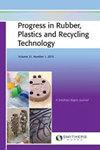Effect of Cu-Al2O3 nanoparticles on the performance of chlorinated polyethylene nanocomposites
IF 1.6
4区 材料科学
Q4 MATERIALS SCIENCE, COMPOSITES
Progress in Rubber Plastics and Recycling Technology
Pub Date : 2022-10-27
DOI:10.1177/14777606221136152
引用次数: 3
Abstract
This work insight into the structural, morphological, thermal, conductivity, dielectric and mechanical properties of chlorinated polyethylene/copper alumina (CPE/Cu-Al2O3) nanocomposites. The Fourier transform infrared spectra (FTIR) of the nanocomposites ensured the presence of Cu-Al2O3 in the polymer chains of chlorinated polyethylene. The X-ray diffractograms (XRD) clearly showed the amorphous nature of the pure polymer and the crystallinity imparted by the addition of the nanosized Cu-Al2O3 into the polymer. The surface morphology of CPE and CPE with different filler loadings was examined using a field-emission scanning electron microscope (FESEM), and the images showed the presence of hemispherical particles of nanometric size. The glass transition temperature (Tg) of the nanocomposite system was determined by differential scanning calorimetric analysis, and the Tg values showed an increase with the loading of nanoparticles. Investigation of electrical conductivity and impedance properties at room temperature with varying applied frequencies demonstrated an enhancement in electrical properties with the addition of nanoparticles. Dielectric constant and dielectric loss exhibit an increasing nature with frequency. The mechanical properties of the polymer nanocomposites, such as tensile strength, modulus, hardness, and impact resistance, were improved while their elongation at break was decreased by the addition of Cu-Al2O3. Several theoretical models were correlated with the experimental tensile strength to study the reinforcing mechanism of Cu-Al2O3 reinforced CPE.Cu-Al2O3纳米颗粒对氯化聚乙烯纳米复合材料性能的影响
这项工作深入研究了氯化聚乙烯/铜氧化铝(CPE/Cu-Al2O3)纳米复合材料的结构、形态、热、电导率、介电和机械性能。纳米复合材料的傅里叶变换红外光谱(FTIR)证实了氯化聚乙烯聚合物链中存在Cu-Al2O3。x射线衍射图(XRD)清楚地显示了纯聚合物的无定形性质以及纳米Cu-Al2O3加入聚合物所赋予的结晶度。利用场发射扫描电子显微镜(FESEM)研究了不同填料负载的CPE和CPE的表面形貌,图像显示存在纳米尺寸的半球形颗粒。通过差示扫描量热分析测定了纳米复合体系的玻璃化转变温度(Tg), Tg值随着纳米颗粒的加载而升高。室温下不同频率的电导率和阻抗特性的研究表明,添加纳米颗粒可以增强电性能。介电常数和介电损耗随频率的增加而增大。Cu-Al2O3的加入提高了聚合物纳米复合材料的抗拉强度、模量、硬度和抗冲击性能,但降低了其断裂伸长率。将几种理论模型与实验抗拉强度相关联,研究Cu-Al2O3增强CPE的增强机理。
本文章由计算机程序翻译,如有差异,请以英文原文为准。
求助全文
约1分钟内获得全文
求助全文
来源期刊

Progress in Rubber Plastics and Recycling Technology
MATERIALS SCIENCE, COMPOSITES-POLYMER SCIENCE
CiteScore
4.40
自引率
7.70%
发文量
18
审稿时长
>12 weeks
期刊介绍:
The journal aims to bridge the gap between research and development and the practical and commercial applications of polymers in a wide range of uses. Current developments and likely future trends are reviewed across key areas of the polymer industry, together with existing and potential opportunities for the innovative use of plastic and rubber products.
 求助内容:
求助内容: 应助结果提醒方式:
应助结果提醒方式:


